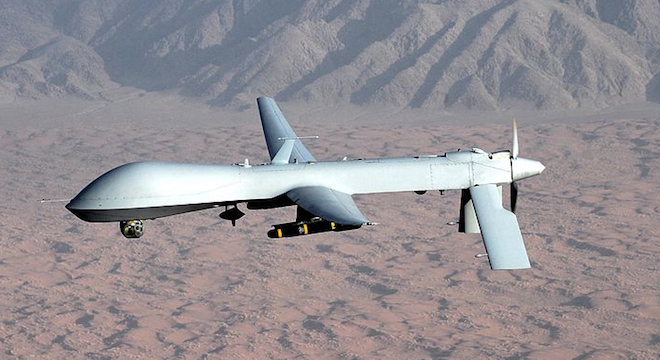America’s controversial unmanned aerial drone fleet, recently credited with killing al Qaeda figurehead Anwar Al-Awlaki, may have just been hit with a serious technological attack.
Wired’s Danger Room reports on Friday that a “computer virus has infected the cockpits of America’s Predator and Reaper drones, logging pilots’ every keystroke as they remotely fly missions over Afghanistan and other warzones.”
The Predator and Reaper drones are perhaps the best known of the Pentagon’s ever-increasing fleet. Both carry cameras and missiles, and conduct lethal strikes and/or surveillance operations in conflict regions around the globe, from Iraq to Afghanistan to Libya to Pakistan to the U.S.-Mexico border.
The virus, which hasn’t interrupted drone operations, was first detected two weeks ago on classified and non-classified drones at the main drone-piloting station, Creech Air Force Base in Nevada, although security specialists have no idea how far it has spread and can’t seem to eradicate it, Danger Room reports.
“We keep wiping it off, and it keeps coming back,” a source close to the matter told Danger Room, “We think it’s benign. But we just don’t know.”
The military also isn’t sure whether the attack was deliberately geared at the drones or whether it was a piece of malware that was introduced to other, civilian computers that insidiously, but unintentionally, made its way over to the military’s equipment, despite the Air Force’s claims to have a “comprehensive response to viruses, worms, and other malware we discover.” For now, the military isn’t “panicking,” according to Danger Room’s sources, but it is updating pilots daily on the matter.
Still, Danger Room notes that “secret data may have been captured by the keylogger, and then transmitted over the public internet to someone outside the military chain of command.”
And the news marks the second time in the past three years that a drone computer security breech has come to the public’s attention. Back in December 2009, Defense Department officials and intelligence officers confirmed that Iraqi militants were able to intercept live surveillance drone video feeds using $26 dollar software program SkyGrabber and others similar to it.
At the time, a defense official told the Wall Street Journal: “There’s been no harm done to troops or missions compromised as a result of it, but there’s an issue that we can take care of and we’re doing so.”
Separately, pilots have also on occasion lost control of drones and the Air Force has been forced to shoot them out of the sky and there have been reports of glitches in a new drone surveillance system.
Use of drones (officially known as “unmanned aerial vehicles” or “UAVs” in military lingo) has increased rapidly since they were first developed in the 1990s, especially under the Obama Administration (to the point that President Obama made a joke during the 2011 White House Correspondents dinner about sending the Predator drone after the Jonas Brothers to protect his daughters.)
As the New York Times reported in June:
The Pentagon now has some 7,000 aerial drones, compared with fewer than 50 a decade ago. Within the next decade the Air Force anticipates a decrease in manned aircraft but expects its number of “multirole” aerial drones like the Reaper — the ones that spy as well as strike — to nearly quadruple, to 536. Already the Air Force is training more remote pilots, 350 this year alone, than fighter and bomber pilots combined.
Indeed, the fact that the drones continue to have such seemingly obvious vulnerabilities despite billions of defense dollars thrown their way is even more problematic when one considers that there are various proposals to bring them into the hands of local police departments stateside. The U.S. government has reportedly already mulled giving drones to Turkey and Pakistan, while smaller drone companies are always looking to sell abroad where legally permissible.
And that’s saying nothing of the controversy over drone accuracy and the number of civilian deaths caused by the vehicles, a matter of ongoing contention between the U.S. government and those on the ground in the warzones where they’ve been deployed.









